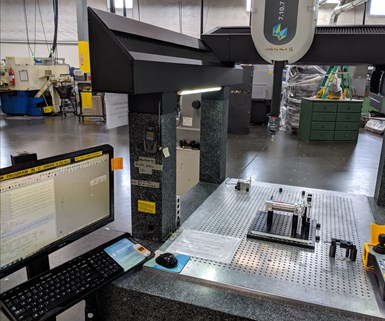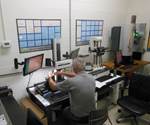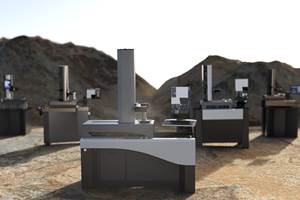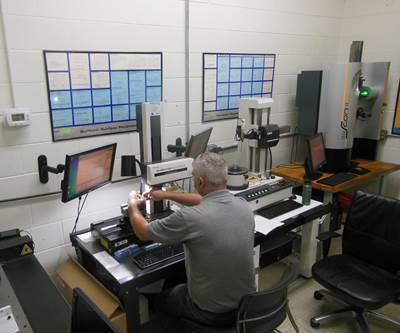An Overview of Metrology for Precision Machining
Metrology helps precision manufacturers ensure the parts they produce fit and work as intended, despite the different languages, processes and measurement systems used.

Bridge CMMs are one type of inspection equipment used in the precision machining industry.
Metrology, the science of measurement, is how manufacturers ensure confident comparisons of global measurement results. For example, metrology helps ensure that vehicles and their parts are accurately and precisely manufactured, measured and assembled despite the different languages, manufacturing processes and measurement systems (such as metric and US) used by the manufacturers who produce the components. Metrology also encompasses techniques and precision measuring tools such as coordinate measuring machines (CMMs) and precision measurement sensors.
Globally Standardizing Precision Machined Parts
Today’s global supply chains require international measuring standards to accurately manufacture machined parts for worldwide distribution and assembly. Multiple factories can precisely machine the same parts from drawings or CAD models. Each manufacturer’s measurement instruments are calibrated with the same specific tolerances. These calibrations ensure that the parts will fit together and work as intended. After calibration, the production machines are set and the quality assurance and quality control are checked for the resulting parts. Quality assurance ensures confidence that quality requirement will be realized, while quality control checks that the requirements have been accomplished.
Types of Metrology Equipment
A coordinate measuring machine is a measuring tool that measures a workpiece by combining its own coordinate system with a probe to measure the physical, geometric points of the part. In addition to accurate measurements, CMMs have the advantage of providing real-time information on the condition of the manufacturing process to the CMM operator. All global CMMs must comply with the ISO 10360 international measurement standards and can be controlled by either an operator or a computer. Five major types of CMMs are used in today’s metrology:
- Cantilever: Used primarily for measuring gages and master parts.
- Bridge: Most popular with scanning and digitizing jobs for the mold, machining and stamping markets.
- Gantry: Used for measuring large, heavy parts such as large molds and dies.
- Horizontal Arm: Used to measure high-volume parts in industries such as aerospace, defense, appliances.
- Portable (PCMM): Handheld 3D and geometric dimensioning and tolerance (GD&T) measurements which can also be ISO 10360-certified.

Touch-trigger probes are the most commonly used type of probe in metrology because they remove touch bias and can be used with computer control.
There are also two major groupings of probes: contact and non-contact. Contact, or tactile probes include:
- Hand Probes: These probes are used to measure curved surfaces, but users must watch for tactile differences between operators.
- Touch-Trigger Probes: These are the most common type of probes. They remove touch bias and can be used with direct computer control.
- Analog Probes: Use CAS technology to measure irregular shapes and contorted surfaces, like sheet metal.
Non-contact probes are used for large, complex geometric, flexible parts. They include:
- Laser Probes: Use laser probe triangulation with a beam of light for high-speed component measurements.
- Vision Probes: Used for high-speed measurement of small, 2D parts with camera images.
- Automatic Probe Changers: Used for part measurement that requires two or more types of probes.
Precision Measurement Sensors in Manufacturing Engineering
As previously noted, global manufacturers need to meet or exceed the specified tolerances of workpieces so they will fit and work as they should. This quality assurance covers manufactured components from medical devices to rocket engines to nuclear power plants. In fact, precision measurement technology ensures the quality assurance of measurements of up to one thousandth of a millimeter. Additional tools for measuring parts include:
- Block gages
- Non-contact sensors
- Displacement transducers
- Flexure, level and mini probes
These measurement technologies precisely measure the height, thickness and width of component as well as elasticity, mass, pressure, temperature, and volume. And, again as previously noted, these measurements can be confidently compared worldwide.
Challenges of Precision Measurement Sensors
If the forces applied by probes to thin or fragile objects are too strong, they may damage the parts. If non-contact probes are not an option, tactile probes can be adjusted to ultra-light touch. Objects, like camshaft bearings, can also be inaccessible or too small for sensors or probes. A possible solution is to use wireless sensors to collect the required information. Another viable solution is to use a portable CMM tool.
Metrology Concepts
In 2004, the International Bureau of Weights and Measures (BIPM) expanded additional definitions and meanings for metrology concepts to include nanometrology. Specifically, the BIPM defines metrology as the science of measurement encompassing both experiments and theories of determinations of any level of uncertainty in any field of science and technology. Additionally, the BIPM divides metrology into three sub-fields: scientific metrology, applied metrology and legal metrology. These sub-fields are defined as:
- Scientific Metrology: This is the basis of all sub-fields and concerns, including development of new measurement methods, realization of measurement standards and transfer of measurement standards to users.
- Applied Metrology: Measurement science concerned with manufacturing processes to ensure appropriateness of measurement instruments, their calibration and quality control.
- Legal Metrology: Concerns regulatory measurement standards and measuring instruments for consumer safety and fair trade.
Applied and scientific metrology are currently working with nanomaterials to form the new multidisciplinary subfield of nanotechnology. Because the physical properties of nanomaterials differ from that of regular sized materials, nanotechnology receives its own definitions.
Metrology Parts | 763-843-1393 | metrologyparts.com
Related Content
PMTS 2023 Product Preview: Measurement
Learn about some of the latest measurement solutions that will be on display at PMTS 2023.
Read MoreKeeping Watch on Small Parts
From watch parts to exotic medical applications, this shop takes on the world of micromachining.
Read MoreThe Value of CMM Controller Retrofits
In this case, new controllers for two coordinate measuring machines — one 26 years old — with new programming software offers the possibility to enable multisensor inspection of critical, turned aerospace components.
Read MoreShop Finds Value in Simple CMM Programming
Icon-driven programming enables all shopfloor personnel to perform CMM inspection, not just those in the quality department.
Read MoreRead Next
Micromachining is About Precision
Holding tolerances on very small part features is not for the faint of heart. The skill is not only in the machining, but cleaning and inspection as well.
Read MoreAutomated Inspection on the Shop Floor
Most machine shops understand the value of automation when it is applied to such operations as turning, milling and grinding.
Read MoreEmerging Leaders Nominations Now Open
Here’s your chance to highlight a young person in your manufacturing business who is on the path to be a future leader moving your company forward.
Read More












.jpg;maxWidth=300;quality=90)










